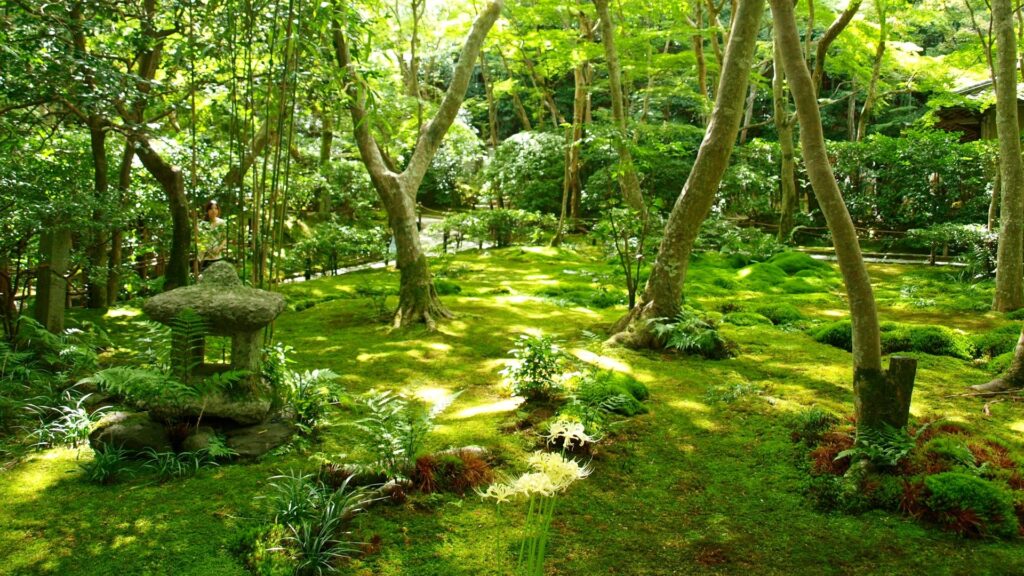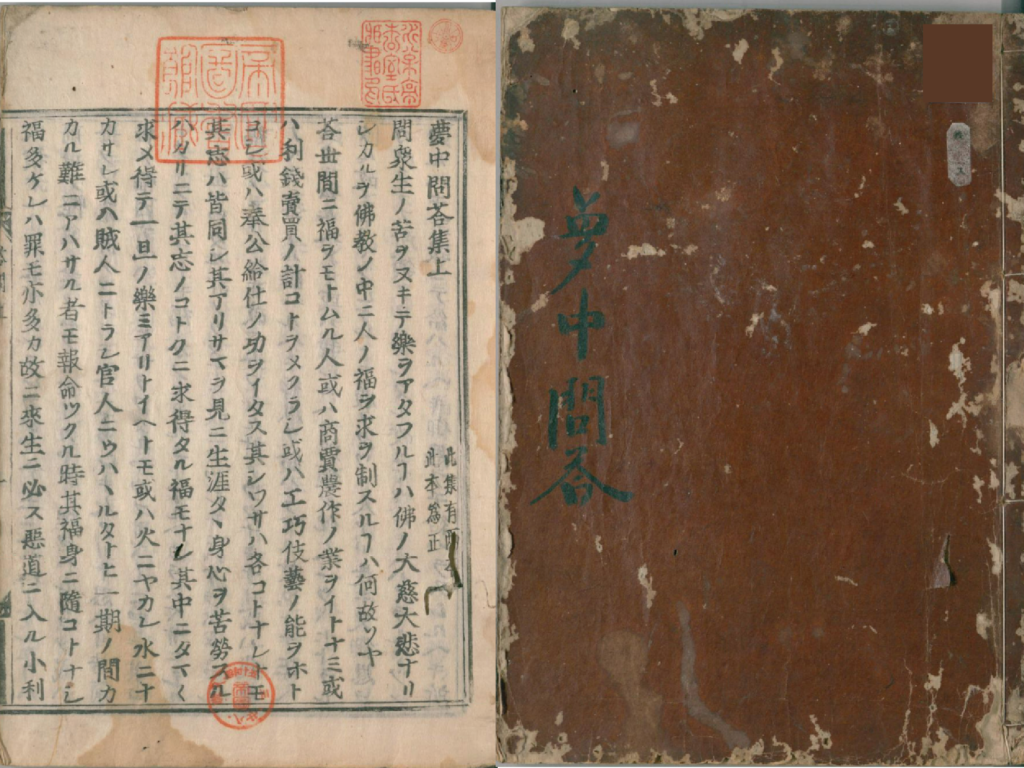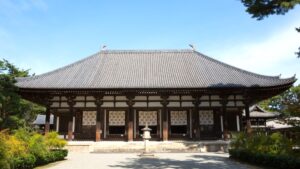Saihoji (Moss Temple): The pinnacle temple created by Zen Priest and Garden Designer, Muso Soseki
The ultimate beauty of nature's formations
Saiho-ji, a UNESCO World Heritage Site, known as the Moss Temple, is a Rinzai Zen Buddhist temple that held a special place in Steve Jobs’ heart, drawing him to visit it several times. This enchanting temple boasts a 5,000 square meter garden adorned with approximately 120 distinct varieties of moss, creating an exquisite tapestry that resembles a lush green carpet. Up close, you can marvel at the diverse shapes and hues of each moss type, resembling everything from dandelion puffballs to coniferous trees like small jewels. As you gaze across the entire garden, you can enjoy subtle differentiating shades of green on the gradually undulating garden as sunlight penetrates through the tree canopy. Walking along the shady path, you may want to inhale deeply to experience the simple but great beauty of the natural surroundings. It’s almost like a self-contained world perfectly harmonized without man’s interference.

The model for the Golden and Silver Pavilions
During the Muromachi Period, the renowned Zen Buddhist and garden designer, Muso Soseki (1275-1351, 夢想礎石), transformed the Jodo temple into a Zen temple and created an innovative garden that embodied Zen spirituality in 1339. Surrounded by nature, he examined and incorporated natural elements and eliminated waste carefully. In the upper section of the two-tiered Karesansui (dry landscape) garden, Shitoan, dedicated to Muso Soseki, alongside Japan's most renowned and oldest Koinzan stone arrangement. (usually close to the public) The lower section is a pond garden centered around Ōgonchi pond that forms the character for "heart. In the Muromachi period (1336-1573), prominent figures like shoguns Ashikaga Yoshimitsu (358-1408, 足利義満) and Yoshimasa (1436-1490, 足利義政) frequently visited Saihoji and drew inspiration from it for the construction of the Golden and Silver Pavilions. Actually, Yoshimitsu spent hours in zazen meditation at Ruriden Hall, trying to get a sense of the teachings of Soseki.
Saihoji’s Resilience: A Tale of Trials and Revivals
Saihoji, originally established during the Nara period (710-794) by Emperor Shomu (701-756, 聖武天皇), faced a decline in the Heian period (794-1185). Its fortunes took a turn for the better during the Kamakura period (1185-1333) when the temple hosted Honen (1133-1212, 法然), the founder of the Jodo sect, and Shinran (1173-1262, 親鸞), the founder of the Jodo Shinshu sect.
About 100 years after Muso Soski created the Zen garden, unfortunately, the temple faced extensive destruction during the Onin War in Kyoto (1467-1477) and a devastating flood in 1485, but it was again rebuilt with the assistance of Rennyo (1415-1499, 蓮如), the head priest of Honganji Temple. Subsequently, the temple fell victim to arson during the Warring States period (1467-1590) and Oda Nobunaga (織田信長) initiated its reconstruction, but the Edo period (1603-1867) brought recurrent flood damage from the overflowing Saihoji River. Ironically, the history of devastation contributed to the enhancing moss-covered landscape we see today. In 1969, the main hall, which had been destroyed during the Onin war, was rebuilt for the first time in 500 years.
Muso Soseki: The Great National Teacher and the Best Zen Gardener

@ Wikimedia Commons
Soseki was discovered by the 96th Emperor Go-Daigo (1288-1333, 後醍醐天皇), and was brought into the political world, like it or not. The time was the turbulent 14th century. Emperor Go-Daigo overthrew the Kamakura Shogunate with his retainer and samurai Ashikata Takauji and his brother, Ashikaga Naoyoshi, subsequently, Ashikaga Takauji forced Emperor Go-Daigo to retreat to Yoshino in Nara prefecture, establishing the Muromachi Shogunate, which itself faced instability. Across the nation, warlords and members of the imperial family fought for its legitimacy, resulting in the division of imperial lineages: the Southern Court under Emperor Go-Daigo and the Northern Court led by Ashikaga Takauji in Kyoto. Leaders including Emperor Go-Daigo and his successive emperors, Shogun Takauji and Yoshinao, his retainers of the Ashikaga Shogunate, as well as the imperial family sought counsel from the insightful and experienced Muso Soseki on matters of the way of life. In short, Soseki taught all those who were trying to govern the country, regardless of whether they were friend or foes. Soseki was given "Kokushi," a national teacher title, by Emperor Go-Daigo and the successive emperors, 7 in total.
Emperor Go-Daigo’s attempt to revive Kyoto ended in disappointment upon his passing in Yoshino. Soseki suggested to Takauji the construction of a temple to repose the spirit of Emperor Go-Daigo, leading to the establishment of Tenryuji Temple. strengthens their karma and deepens their resentment." (Source: Yanagida Seizan)
It was completed at Leveraging his skills and experience from crafting gardens at Saihoji Temple, Soseki completed the Zen garden at Tenryuji Temple, a UNESCO World Heritage Site, as the culmination of Soseki. An exceptional Zen Master, his legacy extends beyond Japanese Zen Buddhism, leaving an indelible mark on the history of Zen gardens. Soseki gave a Dharma talk upon the completion of the Tenryuji Temple. During his speech, he expressed:
"I believe that our nation has been in a mess ever since Emperor Go-Daigo initiated the overthrow of the Kamakura Shogunate. The consequences of this upheaval extended beyond the loss of soldiers' lives, and birds and animals in the mountains and rivers have become collateral damage, as well as the shrines, temples, and residences of both nobility and commoners, all consumed by the flames of war. People suffer from wars not only in the present. Whether they win or lose, it only
Zen's philosophy is a compass for leaders

@NDL Digital Collections
The "Muchu Mondo Shu (夢中問答集)," a collection of Dharma talks based on Zen's principles, comprises 93 chapters addressing Soseki's answers to Ashikaga Naoyoshi's questions, offering valuable teachings for leaders. For example, Chapter 13:
Q: What is the most important as a leader?
A: First and foremost, be fair and honest. If you are fair and honest, you will gain people's trust and organize. If you are not fair and honest, you will lose people's trust and your organization will collapse.
The influence of Zen on Jobs' philosophy and sense of beauty is well known. We have no way of knowing what Jobs thought and felt when he visited Saiho-ji Temple, but it may have been similar to Ashikaga Yoshimitsu's zazen mediation at Saihoji Temple, in which he tried with all his might to learn Soseki's Zen philosophy.
Muso Soseki Timeline
| 1185 | Minamoto Yoritomo established Kamakura Shogunate | - | Kamakura Period |
| 1274 | Mongol invasions to Kyushu (The Bunroku War) | - | |
| 1275 | Muso Soseki was born | Age =1 | |
| 1281 | Mongol invasions to Kyushu again (The Koan War) | - | |
| 1292 | Muso Soseki received precepts at Todaiji Temple | 18 | |
| 1293 | Muso Soseki decided to follow Zen Buddhism | 19 | |
| 1333 | The fall of Kamakura Shogunate/The Kenmu Restoration had begun | 59 | Northern and Southern Courts Period |
| 1333 | Muso Soseki was discovered by Emperor Go-Daigo | 59 | |
| 1335 | Muso Soseki was given "Kokushi," a national teacher title, by Emperor Go-Daigo. | 60 | |
| 1336 | The Kenmu Restoration collapssed / Emperor Go-Daigo established the Southern Court at Yoshino | 61 | |
| 1336 | Ashikaga Takauji estabilished Muromachi Shogunate | 61 | Muromachi Period |
| 1338 | Ashikaga Takauji became Shogun of Muromachi Shogunate | 63 | |
| 1339 | Muso Soseki re-founded Saihoji Temple and started the garden design | 65 | |
| 1341 | Muchu Mondoshu was published | 68 | |
| 1345 | Tenryuji Temple was established | 71 | |
| 1346 | Muso Soseki was given "Kokushi," a national teacher title, by Emperor Komyo | 72 | |
| 1351 | Muso Soseki was given "Kokushi," a national teacher title, by the retired Emperor Kogon | 77 | |
| 1351 | Muso Soseki passed away | 77 | |
| 1392 | The unification of the Southern and Northern Courts | - | |
| 1397 | Golden Pavillion was constracted | - | |
| 1467 | Onin War started (- 1477) | - | |
| 1483 | Ashikaga Yoshimasa move to Ginkakuji under constraction | - |
Recommendations to visit
- Access: 1 hour from Kyoto Station. Take Kyoto bus #76 at C6 bound for "Kokedera, Suzumushi-dera (苔寺・鈴虫寺)." Get off at the final bus stop at "Kokedera, Suzumushi-dera" stop, then a 3-minute walk.
- REQUIRING RESERVATIONS


